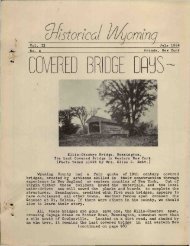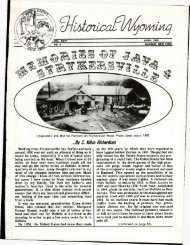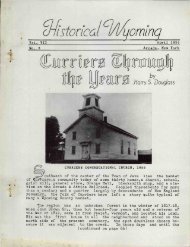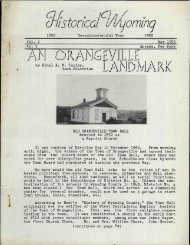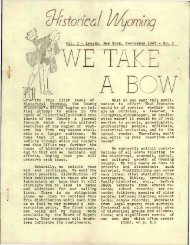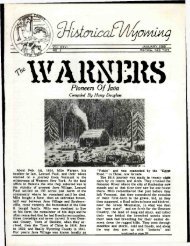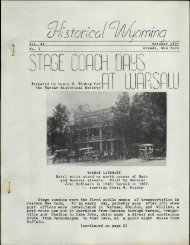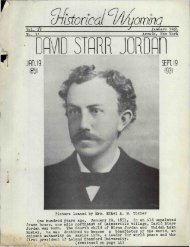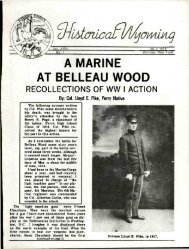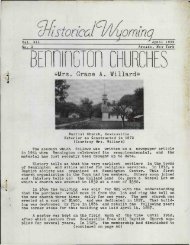Historical Wyoming County July 1958 - Old Fulton History
Historical Wyoming County July 1958 - Old Fulton History
Historical Wyoming County July 1958 - Old Fulton History
You also want an ePaper? Increase the reach of your titles
YUMPU automatically turns print PDFs into web optimized ePapers that Google loves.
Page 106 <strong>July</strong> 19 58<br />
STRYKERSVILLE SKETCHES (cont.)<br />
Mr. Bennion also remembered an old Frenchman,Charles DeBancourt<br />
by name, who lived on the Bartz road north of Plant's Corners. He<br />
was a cooper by trade, also ran a small farm,was a tall man weighing<br />
nearly 200 pounds. Every so often he would walk to Strykersville, a<br />
distance of around four miles, and stay all day. He would go marching<br />
home again singing old country marching songs as he was a soldier<br />
when a young man. Amos H, Castle, Esq. was another of the early<br />
settlers, very well off by the standards of those days, and served<br />
as a justice of the peace for many terms. A familiar figure in the<br />
vicinity was Chandler Barber, a surveyor, who traveled about in a<br />
two-wheeled cart and made use of field notes prepared from those of<br />
Joseph Ellicott.<br />
Location of a cabin or home to a good supply of water was most<br />
essential. There was always a good supply of water on the east side<br />
of Strykersville where the first wells were dug and stoned up, about<br />
three or four feet in diameter and some about 25 feet deep. Water<br />
was drawn by an oaken bucket by means of a wooden roll run by a crank<br />
and a two-inch wide strap;at the surface the bucket caught on a trip<br />
that dumped the water through a spout and into the pail,all of which<br />
was attached to an open rank or crib. Later chain pumps were used<br />
with wooden pump logs of cucumber wood, in length around 12 feet,<br />
about ILXIL, and bored with a two-inch hole. The logs were joined by<br />
means of a wooden coupler bound with iron rings. Later, the same<br />
logs were used in a suction pump operated by a handle and were known<br />
as stock pumps. Subsequently, iron pipes were driven for water and<br />
several flowing wells were located, some as deep as 127 feet, all of<br />
which flowed for years. The usual method of locating a well was by<br />
means of a crotch stick plan employed by certain individuals who<br />
made it a business of locating water.<br />
On the Harvey Stevenson farm on the west side of the village<br />
was what was known as the "Robber's Cave," where it was reported a<br />
local tough gang secreted their stolen loot. Mr. Bennion remembered<br />
around the year 1883, it was still visible on the farm on the Creek<br />
Road west of Buffalo Creek. The cave was west of the farm house at<br />
the edge of the woods. It was a dug-out affair with a ledge of rock<br />
overhead, and 75 years ago there remained a door of wood with a hasp<br />
to lock the same; about were bushes which almost obscured the site.<br />
Boys bent on exploring the hideout were shooed away by the owner. It<br />
is said that the gang of thieves used to operate throughout the<br />
vicinity, stealing almost anything that looked like profit to them,<br />
including horses, cattle, clothes from a wash line, and made entry<br />
into houses and nlaces o^ business. One of the gang, the only one<br />
then alive,was one Beebe, an elderly man with a head of red hair and<br />
a long heard. Apparently they were a clever group,able to move goods<br />
rapidly from olace to place, disguise them,and dispose through other<br />
underworld outlets. Whether they were ever successfully apprehended<br />
is not known.<br />
(continued on page 107)



